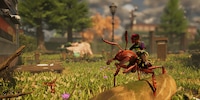
Background information
Through the park with the insect battle tank: I played "Grounded 2"
by Debora Pape
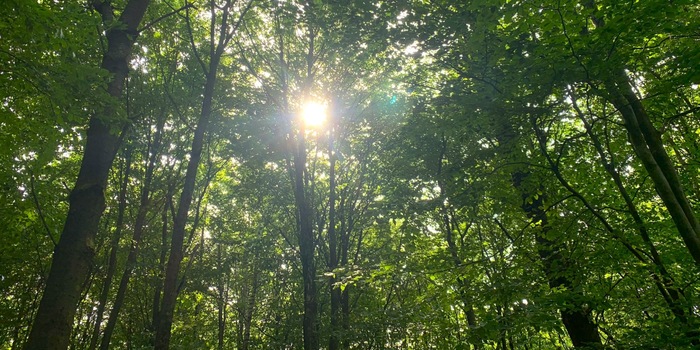
I treated myself to a thorough forest bath – under professional guidance in a Shinrin Yoku seminar. And while it did stimulate new ideas, I’d rather do my forest relaxation sessions alone in future.
Forest bathing doesn’t involve jumping into a lake surrounded by trees. Although, this would certainly help too. No, forest bathing, also known as Shinrin Yoku, must be taken literally in another sense. You don’t immerse yourself in water, but in the forest itself. This may sound strange at first, but studies have shown that the process can have an extremely positive effect on your health.
I wanted to know what it was all about and officially signed up for a forest bathing session. For three hours, I say goodbye to city life with all its hustle, bustle and noise and immerse myself in the tranquillity of a nearby forest.
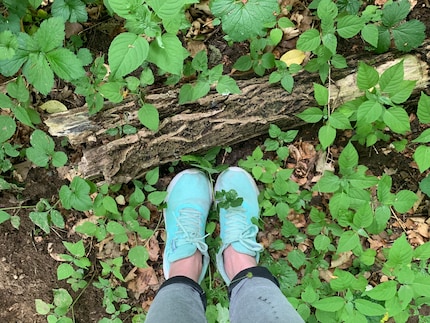
My forest swim on the outskirts of Hamburg begins in front of Haus der Wilden Weiden, a natural history museum in the Höltigbaum nature reserve.
It’s a hot, dry summer day and I’m looking forward to the coming cool in the shade of the trees. Alongside me, seven other peace seekers found their way into the forest. The «bathing tour» is led by nature educator Angela von der Geest, who calls herself the forest lifeguard (German: «Waldbademeisterin»). Rightly so, as will become clear in the course of the afternoon. We gather in front of the forest and first get a small introduction to the activity.
Shinrin Yoku, as forest bathing is called in Japanese, was developed in the 1980s. At the time, the Japanese government was looking for a way to offer its ever-growing urbanised society a recreational opportunity to counterbalance city stress. Spending mindful and conscious moments in nature, at best in a forest, seemed like the right kind of relief for stressed city dwellers, and so forest bathing was established. At the same time, the Japanese government initiated extensive research projects to study the effects of Shinrin Yoku. By now, studies the world over offer varied evidence for its positive effects on the body and mind. From eliminating stress, to a reduction of anxiety and the effects of depression, to strengthening the immune system.
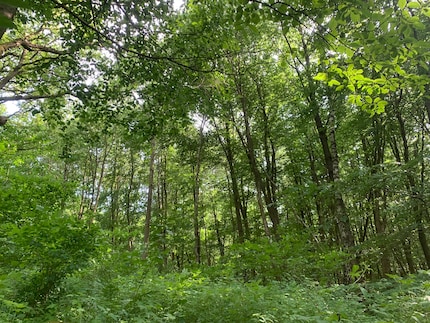
Our forest lifeguard radiates an incredible calmness. If it’s down to the forest life, my experience can only be relaxing.
After some background information, our small group heads out. On a meadow in front of the first row of trees, we stop and gather in a circle. To get in the mood for what’s to come, our lifeguard begins with some mindfulness and breathing exercises. We should come to rest, decelerate and transition to this other, relaxing world. Slowing down is the goal, it’s «the only pace allowed in the forest for the next few hours», as is constantly reiterated. Fifteen minutes and a few Qi Gong exercises later, I actually already feel somewhat decelerated, but now I really want to finally dive into the forest. That’s where we are heading now, slowly and silently.
As soon as we leave the first trees behind us, I get the feeling of being swallowed up by the calm, cool atmosphere of the forest. I truly feel immersed – the bathing begins.
We walk a bit into the forest until we’re fully surrounded by trees. A bit off the path, the lifeguard spreads a blanket on the ground. It’s now our base, to which we’ll return again and again after various forest journeys.
As a botanist who has long studied trees and how they age, however, I’m just distracted at this point. The woodland is wild and untamed, which I really enjoy. However, most of the trees are relatively young and as I’m about to learn, this is just a patch of forest. Too bad, I’d have liked an old, large, dense forest.
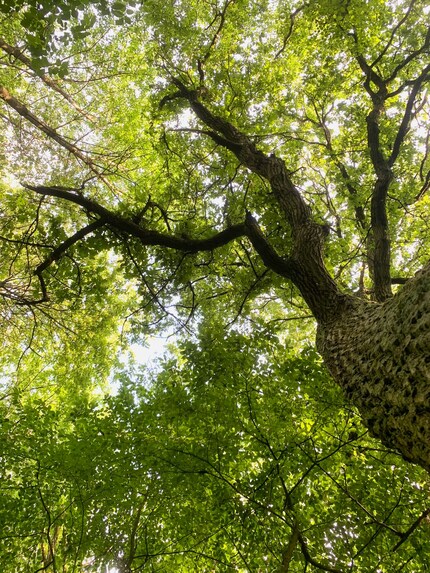
Now things are finally really getting underway. We receive our first assignment and are allowed to head off in all directions until the «owl» calls us back. The «owl» is a small, carved wooden pipe in the shape of an owl. Our first mission: explore the forest, look at what we see and let it affect us, but don’t touch anything. We spread out in different directions.
I notice how I instinctively try to distance myself from other participants. I want to experience the forest in peace for myself, the presence of others disturbs me a little. I start to wonder if it wouldn’t have been more useful to just go into a really lonely old forest alone than to decelerate here with a group as instructed. Welp, it’s too late for a change of plans now, so I decide to get involved in the experience as best I can.
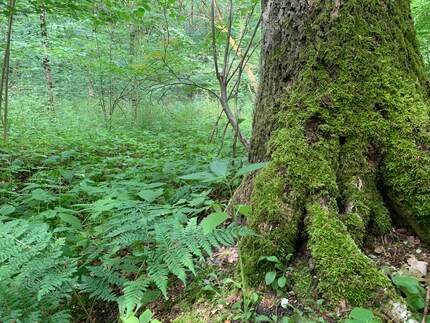
After some time, during which everyone roams around the forest by themselves, we hear the owl calling and gather around the blanket on the ground again. I’m the last to arrive back at base. I wonder if I took the deceleration thing more seriously than the others.
The next assignment follows: now we’re allowed and expected to touch, smell and – if it seems appropriate – taste the forest. My determination draws me away from the others. I stroke a few leaves and finally lean against a tall tree. I’ll pass on the tasting. But again there’s doubt. Is this perhaps too airy-fairy for me after all? If I were alone now, I’d look for a nice place and let the forest work on me – completely without order, other people and inner anxiousness I’d overhear the owl whistle. These thoughts can’t quite be pushed away by the time we once again reunite.
After a little exchange of who felt, smelled and tasted what, we get the next task: taking off our shoes! Some in the group look slightly confused, and although I like to walk around barefoot, I’m also a bit surprised by the proposal. But sure, why not?
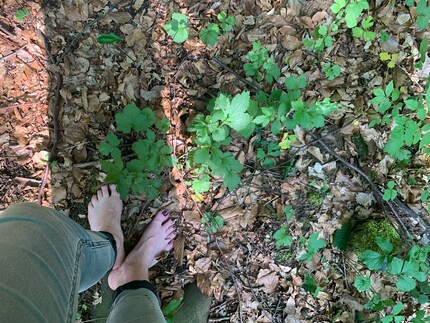
And so comes my lightbulb for the day: the forest floor is incredibly soft. My feet sink very easily into the pleasantly cool, loose forest soil. I’m fascinated by the unexpected experience and thus have an answer to the question of whether the guided forest bathing tour was the right choice: yes, it was! I probably wouldn’t have come up with the idea to take off my shoes in the forest alone. And I already know that, if at all possible, this will be a part of every future forest visit for me.
After a few minutes, during which everyone has let the unfamiliar feeling take effect on them, we gather around the blanket again. The next job follows: listening. In great detail, the forest lifeguard describes how we should use the next quarter of an hour. Listening selectively in different directions one after the other. What stands out? Which birds can we identify by song? Do we manage to block out the quiet noise of the nearby highway or better reinterpret it as the sound of a river, for example? In addition, we can choose to leave our shoes off or put them back on. An easy choice for me: off.
Now, finally, I can do what I had intended to do from the start: I look for a cosy spot (far away from the others, of course), sit down, lean against an old, gnarled oak tree and close my eyes. For a moment, I try to listen specifically in one direction only, which I rather struggle with. And so I just enjoy «directionless» silence, the chirping of the birds and rustling of the wind in the dense canopy. I’ve finally arrived completely in the forest…
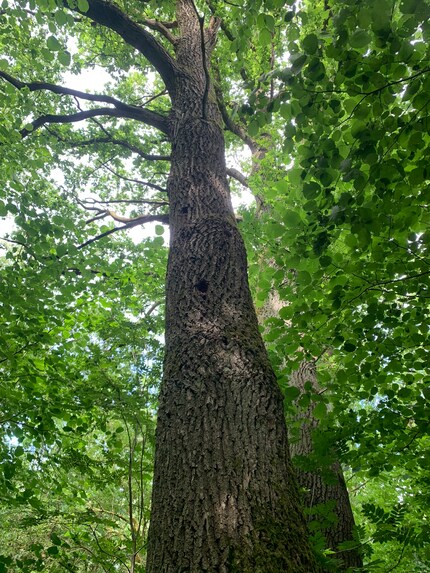
… until the owl calls again. I admit, at this moment, the ole critter is bugging me, disturbing my peace. I’d have liked to stay at my oak tree, but now I trot to the others, resigned to my fate. The next task isn’t quite my cup of tea. Everyone gets a mirror to hold at a 90-degree angle just above or below the eyes, to add a new perspective. We can also use it to look at leaves from below, for example, or to peek into a hollow tree trunk. After a few minutes I run out of ideas, so I wait rather impatiently for the owl call this time. The feedback from other forest bathers is positive, mirror aversion seems to be a «me» thing. But no biggie, because now comes the second highlight of the event.
While we were out with the mirrors, the forest lifeguard strung hammocks between the trees all over the forest. The last half hour is very much to my taste and again something I wouldn’t have done on my own. Everyone finds their hammock. To my relief, there are no other tasks, we’re allowed to just hang out, relax and doze off. Wonderful, it’s what I had wished for. I swing into my mat and am just happy.
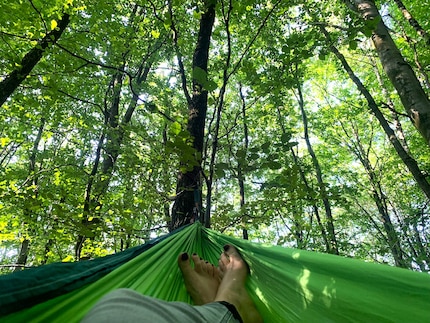
When we leave the forest some time later, it really is a bit like emerging from another world. I notice not only in myself, but also in the other participants, that the forest has had an effect on us. We’re decelerated, calmer, more satisfied and somehow fulfilled. Overall, the feedback from the group is very positive. But I’m not the only one who felt a little pressured by the timed nature of our trip. Another participant notes that he never could let go completely because he was worried about missing the call to the blanket. Another, like me, is still barefoot until leaving the forest and delighted to have had the experience.
Overall, forest bathing with professional guidance was definitely worth it for me. After three hours I’m decelerated, relaxed, inwardly calm and content. Scientific findings on Shinrin Yoku here or there, this feeling is enough to convince me of the positive effects of forest bathing. And even though I struggled with our assignments sometimes, this was exactly the point: I found new ideas that will enrich my future visits to the forest. And the forest has occupied my thoughts again.
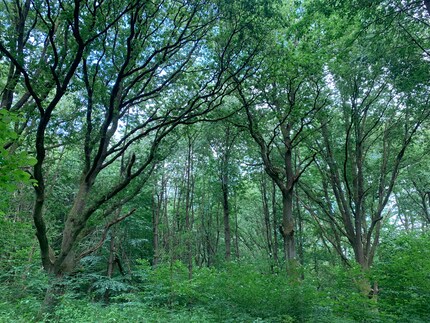
I’ll definitely take a small forest bath break more often – completely unguided but with a hammock along for the ride.
Header image: Anna Sandner
Science editor and biologist. I love animals and am fascinated by plants, their abilities and everything you can do with them. That's why my favourite place is always the outdoors - somewhere in nature, preferably in my wild garden.
Interesting facts about products, behind-the-scenes looks at manufacturers and deep-dives on interesting people.
Show all